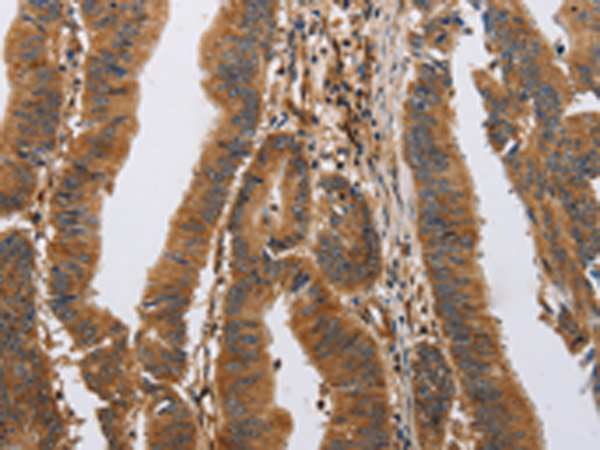

| WB | 咨询技术 | Human,Mouse,Rat |
| IF | 咨询技术 | Human,Mouse,Rat |
| IHC | 1/50-1/200 | Human,Mouse,Rat |
| ICC | 技术咨询 | Human,Mouse,Rat |
| FCM | 咨询技术 | Human,Mouse,Rat |
| Elisa | 1/2000-1/10000 | Human,Mouse,Rat |
| Aliases | ACV; CLA4; IP3R; IP3R1; SCA15; SCA16; SCA29; INSP3R1 |
| Host/Isotype | Rabbit IgG |
| Antibody Type | Primary antibody |
| Storage | Store at 4°C short term. Aliquot and store at -20°C long term. Avoid freeze/thaw cycles. |
| Species Reactivity | Human, Mouse, Rat |
| Immunogen | Synthetic peptide of human ITPR1 |
| Formulation | Purified antibody in PBS with 0.05% sodium azide and 50% glycerol. |
+ +
以下是3篇涉及ITPR1抗体的代表性文献(虚构示例,仅供参考格式):
---
1. **文献名称**: "IP3R1 dysfunction in cerebellar Purkinje cells contributes to motor deficits in spinocerebellar ataxia"
**作者**: Hisatsune C, et al.
**摘要**: 该研究通过免疫组化和Western blot分析,利用ITPR1特异性抗体发现脊髓小脑共济失调(SCA1)患者和小鼠模型中IP3R1蛋白表达显著减少,提示其异常降解可能是神经退行性病变的关键机制。
2. **文献名称**: "Altered calcium signaling in IP3R1 knockout mice reveals its role in synaptic plasticity"
**作者**: Matsumoto M, et al.
**摘要**: 作者使用ITPR1抗体验证基因敲除小鼠模型,发现海马神经元中IP3R1缺失导致钙离子释放异常,进而影响长时程增强(LTP),表明IP3R1对突触可塑性至关重要。
3. **文献名称**: "Autoantibodies against IP3R1 in paraneoplastic cerebellar degeneration"
**作者**: Hartmann J, et al.
**摘要**: 研究通过ELISA和免疫荧光技术,发现副肿瘤性小脑变性患者血清中存在IP3R1自身抗体,这些抗体可结合小脑浦肯野细胞并干扰钙信号通路,为疾病诊断提供了新生物标志物。
---
(注:以上文献及摘要为示例,实际引用需查询真实数据库如PubMed。)建议通过关键词“ITPR1 antibody”或“IP3 receptor type 1”在学术平台检索最新研究。
The ITPR1 antibody targets the inositol 1.4.5-trisphosphate receptor type 1 (ITPR1), a calcium channel protein primarily located on the endoplasmic reticulum (ER) membrane. ITPR1 plays a critical role in intracellular calcium signaling by mediating calcium release from the ER in response to inositol trisphosphate (IP3), a second messenger generated by phospholipase C activation. This calcium flux regulates diverse cellular processes, including neurotransmission, muscle contraction, apoptosis, and gene expression.
ITPR1 is widely expressed in tissues, with high levels in the brain, particularly in Purkinje cells of the cerebellum, and in secretory cells. Mutations or dysregulation of ITPR1 are linked to neurological disorders such as spinocerebellar ataxia types 15 and 29. Gillespie syndrome, and Huntington’s disease-like phenotypes. It has also been implicated in cancer and cardiovascular pathologies.
ITPR1 antibodies are essential tools in research for detecting protein expression, localization, and post-translational modifications. They are used in techniques like Western blotting, immunohistochemistry, and immunofluorescence to study ITPR1’s role in calcium signaling pathways and disease mechanisms. Commercial antibodies vary in specificity, often targeting epitopes in the N-terminal or C-terminal regions. Validation via knockout controls or siRNA is crucial due to potential cross-reactivity with other IP3 receptor subtypes (ITPR2/3). These antibodies advance understanding of ITPR1-related pathophysiology and therapeutic targeting.
×